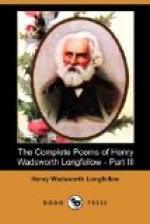“If one of the young female huskers finds a red ear of corn, it is typical of a brave admirer, and is regarded as a fitting present to some young warrior. But if the ear be crooked, and tapering to a point, no matter what color, the whole circle is set in a roar, and wa-ge-min is the word shouted aloud. It is the symbol of a thief in the cornfield. It is considered as the image of an old man stooping as he enters the lot. Had the chisel of Praxiteles been employed to produce this image, it could not more vividly bring to the minds of the merry group the idea of a pilferer of their favorite mondamin. . . .
“The literal meaning of the term is, a mass, or crooked ear of grain; but the ear of corn so called is a conventional type of a little old man pilfering ears of corn in a cornfield. It is in this manner that a single word or term, in these curious languages, becomes the fruitful parent of many ideas. And we can thus perceive why it is that the word wagemin is alone competent to excite merriment in the husking circle.
“This term is taken as the basis of the cereal chorus, or corn song, as sung by the Northern Algonquin tribes. It is coupled with the phrase Paimosaid,—a permutative form of the Indian substantive, made from the verb pim-o-sa, to walk. Its literal meaning is, he who walks, or the walker; but the ideas conveyed by it are, he who walks by night to pilfer corn. It offers, therefore, a kind of parallelism in expression to the preceding term.” — Oneota, p. 254.
Pugasaing, with thirteen pieces.
This Game of the Bowl is the principal game of hazard among the Northern tribes of Indians. Mr. Schoolcraft gives a particular account of it in Oneota, p. 85. “This game,” he says, “is very fascinating to some portions of the Indians. They stake at it their ornaments, weapons, clothing, canoes, horses, everything in fact they possess; and have been known, it is said, to set up their wives and children and even to forfeit their own liberty. Of such desperate stakes I have seen no examples, nor do I think the game itself in common use. It is rather confined to certain persons, who hold the relative rank of gamblers in Indian society,—men who are not noted as hunters or warriors, or steady providers for their families. Among these are persons who bear the term of Iena-dizze-wug, that is, wanderers about the country, braggadocios, or fops. It can hardly be classed with the popular games of amusement, by which skill and dexterity are acquired. I have generally found the chiefs and graver men of the tribes, who encouraged the young men to play ball, and are sure to be present at the customary sports, to witness, and sanction, and applaud them, speak lightly and disparagingly of this game of hazard. Yet it cannot be denied that some of the chiefs, distinguished in war and the chase, at the West, can be referred to as lending their example to its fascinating power.”




